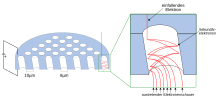Microchannel plate
A microchannel plate (the English term microchannel plate , abbreviated MCP) is a flat, image-resolving secondary electron multiplier .
It is used for the low-noise amplification of small currents of free electrons, ions or high-energy photons. These strike the plate and generate secondary electrons there, which can then be detected.
Structure and functionality
An accelerating voltage is applied between the two metalized plate sides, the plate itself is made of lead glass. The inner walls of the channels are made of a semiconductor material. Like a sieve, the plate is perforated or traversed by microscopically fine channels, which typically have a hole spacing of approx. 10 µm and a diameter of approx. 6-25 µm. The plate has a thickness of a few tenths of a millimeter (up to approx. 1 mm) and the channels are tilted by approx. 10 ° relative to the plate axis, so that the incident electrons are certain to hit the channel wall several times. They are then accelerated by an electrical voltage applied between the plates along the channels and multiply with each wall impact, so each individual channel behaves like a microscopic channel electron multiplier , or the stepwise secondary electron multiplier in photomultipliers .
On the exit side, the number of electrons has increased by around 1000 times as a result of multiple collisions with the channel wall. The amplified (= multiplied) electrons are directed to the actual detector through a post-acceleration section, usually a fluorescent screen , but also, for example, an ebCCD - the electron bombarded CCD , a special form of the CCD for the detection of free electrons.
application
Microchannel plates are used, for example, in image intensifiers and in electron spectroscopy and in mass spectrometry . In the latter case, the entry side can be coated with special materials in order to increase the sensitivity for the type of particle to be detected. This additional coating, for example, converts ions into electrons more effectively than in uncoated MCPs. Since free electrons are to be detected, MCPs can only be used in a high vacuum. Another application of MCPs is to increase the brightness of cathode ray tubes. MCPs are therefore used in fast analog oscilloscopes (Tektronix 7104, 2467B) in order to make even seldom occurring events visible.
Quality factors
Quality- determining parameters are in particular:
- Gain (multiplication factor for the electrons at a given acceleration voltage)
- Dynamics (the quotient of the largest possible to the smallest signal to be detected), the largest possible signal is limited to approx. 10% of the cross current. Due to the applied acceleration voltage, the cross-current flows through the semiconducting plate material itself - regardless of the number of electrons that hit it (the multiplied electrons are withdrawn from the cross-current)
- spatial resolution
- Sensitivity (detection efficiency: quotient of detected electrons to be hit)
- The pulse height distribution (or pulse height distribution , abbreviated to PHD) indicates how much the number of exiting electrons fluctuates when individual electrons hit the input side. This fluctuation should be as small as possible, as should the fluctuation in the transit time of the individual electron showers during amplification. Both are heavily dependent on the acceleration voltage, which is typically between 400 volts and 1000 volts.
Finally, the homogeneity of all these parameters over the entire active area of the MCP is a decisive quality feature.
Manufacturing
The most critical factor in an MCP is the evenness of the microscopic channels. The production requires the mastery of techniques similar to those used for fiber optics : there, each and every one of the fused light guides consists of core glass and cladding glass, which are fused together in a first step, such as macaroni / bucatini individually shrunk onto spaghetti. As a result, an increasingly large number of these bundled individual strands are fused together and drawn or pressed in a semi-liquid state, whereby microscopically fine structures can be obtained with extremely high regularity after several passes.
The heterogeneous strand drawn in this way is then cut into fine slices, from which, in the case of the MCP, the core glass is chemically etched out - here the remaining cladding glass forms the active semiconductor of the component.
literature
- Monika Wolf: Multi-Channel Plates * . In: Physics in Our Time . tape 12 , no. 3 , 1981, p. 90-95 , doi : 10.1002 / piuz.19810120305 .
- Joseph Ladislas Wiza: Microchannel plate detectors . In: Nuclear Instruments and Methods . tape 162 , no. 1 , June 1, 1979, pp. 587-601 , doi : 10.1016 / 0029-554X (79) 90734-1 .
